What is spondylosis and how is it treated?


Spondylosis is a term used for different conditions that cause chronic non-inflammatory processes of the spine accompanied by gradual wear, tear and destruction of the fibrous ring of the intervertebral disc, compaction of the anterior longitudinal ligament and the formation of marginal bone growths (osteophytes) of the vertebral bodies.
Short information about spondylosis
Spondylosis causes
Spondylosis usually manifests itself in persons of pre-retirement age, much less often in young people. The latest research data indicate that bone growths are the physiological adaptation of the spine to constant stress, therefore it is necessary to spare the spine from childhood.
Typical causes of spondylosis:
- The progression of osteochondrosis;
- Excess weight;
- Improper posture;
- Inadequate physical activity when playing sports;
- Akinesia (loss or impairment of the power of voluntary movement);
- Professional activity (frequent lifting of weights during work, prolonged uncomfortable posture, sedentary lifestyle, regular vibration);
- Chronic regular injuries of the vertebral ligaments;
- Deposits of metabolic products;
- Constitutional predisposition;
- Osteoporosis;
- Some infectious diseases (tuberculosis, brucellosis);
- Concomitant pathology (diabetes mellitus).
The main factor in the development of the disease is old age. But recently, cases of the disease have become more frequent in young people who lead a passive lifestyle. The fact is that the intervertebral disc feeds on the vessels of the muscles. If the muscles are atrophied, the disc lacks nutrients, it dries up and atrophies itself.
Bony growths can form anywhere in the spine. Their most dangerous location is in the region of the cervical vertebrae.
Causes of spondylosis in the cervical spine:
- Torticollis (muscle condition causing the head tilt down);
- Neck injury;
- Prolonged spasm of the cervical muscles;
- Poor posture.
Spondylosis is often found in the lumbar spine, since it is this part of the spinal column that experiences significant stress.
Causes of spondylosis in the lumbar spine:
- Pregnancy;
- Inactivity;
- Inadequate one-time workloads (work in the country side on weekends);
- Excess weight;
- Systematic hard physical labor
- Trauma and severe bruises;
- Prolonged static loads (sitting at the computer in an uncomfortable position for a long time);
- Professional sports.
The mechanism of development of spondylosis

Due to various reasons provoking pathological microprocesses in the spine, degenerative changes occur in it. Under abnormal pressure, the intervertebral discs approach each other (for example, under the extreme pressure of the body weight), their fibrous fibers are squeezed out of the vertebral body in order to contain and minimize their pathological exit, bone protrusions called osteophytes are formed.
Spondylosis develops slowly over several years; osteophytes cannot appear suddenly on a healthy spine.
At stage 1, osteophytes do not protrude beyond the vertebral bodies. At stage 2, they grow beyond the limits of the intervertebral disc. At the stage 3, they form a powerful bone brace, which limits the discs on the sides with a kind of "hooks".
In the future, irritation occurs with bone spines of the nerve roots, pain appears. In addition, under normal conditions, a healthy root sends signals to a certain organ, but when the nerve is squeezed, the signal is lost, the organ begins to lose its vitality, since it does not understand how to act correctly. A vicious circle ensues. Microtrauma aggravates degenerative destruction, the diameter of the spinal canal decreases; vertebrae, approaching, can fuse together, the mobility of the affected segment is limited. As a result, the spine ossifies. In this case, you have to resort to traumatic and complex radical interventions.
Spondylosis symptoms
Bony growths characteristic of spondylosis block a specific segment of the spine. The muscles surrounding this segment spasm, resulting in poor nutrition for the vertebrae. Each spine in a segment (and in the entire spine) is unique. It is responsible for certain functions of the body, therefore, the coordinated work of the body's organs is disrupted. The disease gradually progresses, new osteophytes appear, which limit the mobility of more and more areas of the vertebral segment. In the initial period, the disease proceeds unnoticed. First, there is discomfort, then a dull, unobtrusive local pain in the back or neck, a desire to change posture. Spondylosis can be found by chance when diagnosing a concomitant disease. In the future, more serious complaints appear, which depend on the localization and prevalence of the process, and the patient goes to the doctor.
Common symptoms of spondylosis:
- Dizziness and loss of consciousness;
- Changes in hearing and vision;
- Painful sensations in the spinal column, all over the back and neck;
- Violation of gait;
- Unusual skin sensations - paresthesia in the form of "creeping", tickling, etc.
- Pain is prolonged, does not have a clear localization, appears due to positional load (long driving), and not due to awkward movement;
- Pain is worse at night, difficult to find a soothing position;
- Fast fatiguability.
The disease rarely involves all parts of the spinal column in the pathological process, usually one part is affected - the lumbar or cervical, while no more than 1-2 segments are affected.
Symptoms of cervical spondylosis

Spondylosis of the cervical spine is the most common form of the disease, as the number of people who work at a computer and experience tension in their cervical muscles due to stiff posture is only increasing. Localization of pathology in the neck is the most dangerous. In this case, the arteries carrying blood to the head can be pinched. If the cervical spine is damaged, pains appear in the neck, head, arms, dizziness, the shoulder girdle is tense, pressure drops are possible, and there is a risk of stroke. In a relaxed lying position, the state of health improves.
Signs:
- Difficulty moving the head;
- Crunch when trying to turn the head;
- Drops in blood pressure figures;
- Flashing "flies" before the eyes and other discomfort of vision;
- Congestion of the ears and tinnitus (noise or ringing in the ears);
- Pain in the arm on the affected side.
Thoracic spondylosis symptoms

With the damage to the thoracic region, the vital activity of the internal organs changes. But since the thoracic spine is well protected and stabilized, the localization of pathology in it is quite rare. The signs of thoracic spondylosis are blurred and appear clearly already in the later stages, when a hernia develops in the affected region. The danger of this localization is that the patient feels the manifestations of the disease when the treatment becomes problematic.
Signs:
- The pain is one-sided;
- Chest pain;
- Pain is blurry.
Lumbar spondylosis symptoms

The loin is a favorite location for spondylosis. This is due to the fact that it is the lumbar vertebrae that experience the greatest stress. With the damage to the lumbar vertebrae - there is pain in the lower back, in the leg, can cramp the calves, there are problems with urination, defecation, reproductive functions. Spondylosis of the lumbar spine is characterized by a symptom of "numb feet". The discomfort only goes away when the patient bends the back or lies down in a curled up fetal position.
Signs:
- Stiffness in the back;
- Intermittent claudication;
- Problems with emptying the bladder and bowels;
- Increased pain while walking.
Diagnostics

Diagnosis of spondylosis, like any other disease, is based on interviewing the patient, examination and additional research methods.
1. Interviewing the patient.
The doctor, collecting a history of life and illness, clarifies the following points:
- Is there osteochondrosis;
- Whether you have had a stroke;
- Whether there is Parkinson's disease;
- Whether you have had any injuries;
- For how long does the patient sit in a tense position (working at a computer, for example);
- When and where back pain appears, how it is provoked;
- Whether there are flat feet;
- Whether the patient is engaged in sports, if he/she does, what kind of sports;
- Is there lameness and a feeling of numbness (paresthesia).
2. Examination of the patient.
The doctor examines the patient, pays attention to the posture, palpates the spine, revealing painful areas and muscle tension along the spine, asks to twist the head, throw it back, assess the increase in pain. When the pathology is localized in the lower back, the embryo pose and bending forward are important - in these body positions, the patient will feel better.
3. Clinical tests.
Laboratory methods will help clarify the diagnosis. Usually, a clinical analysis of blood and urine, biochemistry is prescribed, the amount of vitamin D, calcium, magnesium, etc. is determined in a biofluid.
4. Instrumental examination methods:
- X-ray - allows identifying osteophytes; they are asymmetric, irregular, the height of the intervertebral discs is preserved;
- Computed tomography - assesses the condition of the intervertebral discs in more detail, revealing structural pathology layer by layer;
- MRI - more accurately identifies the affected discs and determines the number of growths.
5. Additional methods.
For differential diagnosis, the patient may be offered to undergo densitometry (exclude-confirm osteoporosis), Doppler ultrasound (if vascular pain is suspected), electroneuromyography (to assess nerve conduction).
6. Consultation of specialists.
For a more accurate diagnosis and development of the correct treatment strategy, it is often necessary to resort to specialists in related disciplines - a neurologist, rheumatologist, orthopedist, cardiologist, urologist, gynecologist, and psychotherapist.
After competent and timely treatment, one can observe an improvement in the patient's condition, the return of the flexibility of the spine, and a decrease (disappearance) of pain.
Prevention of spondylosis

In order for the spine to remain healthy for many years, the following recommendations of orthopedists must be followed.
Primary prevention of spondylosis
1. Optimize working conditions:
- The height of the work table and chair must be adjusted:
- The seat in the car must be adjusted to the driver;
- Special orthopedic rollers should be placed under the back;
- Feet while sitting should rest on the floor or be located on a bench, knees - just above the hips;
- The upper border of the working screen should be at eye level;
- If you have to stand for a long time, then you need to change your position every 10-15 minutes, moving the body weight from one leg to the other;
- After 45-50 minutes of sedentary work, take a break, during which you need to walk, do elementary gymnastics, or at least sit back and relax;
- Avoid static forward bending, try to fix your back straight;
2. Consider healthy sleeping conditions:
The spine can relax only by being in a horizontal position, as a rule, this happens during sleep. In order for unloading to be correct and beneficial, you must remember the following points:
- The mattress should not be too hard or too soft;
- The pillow should not be large and loose;
- For a comfortable position, you can put bolsters under the lower back, under the knees, elbows, and/or a pillow between the legs;
- It is not advisable to sleep on your stomach, it is better to choose the embryo position or lie on your back.
3. Be careful about physical activity:
- Lifting any weights, be careful - the back should be straight, legs bent at the joints; movement is smooth, without jerks;
- The load should be as lightweight and easy to move as possible, comfortable for two-handed lifting;
- Do not lift the weight while turning the torso;
- Load over 5 kg (11 lbs) must be evenly distributed between two hands;
- It is better to use a backpack;
- Any weight should be carried with both hands, holding it to the chest.
4. Choose an adequate sport:
Contrary to the opinion about the usefulness of hanging on the horizontal bar, doctors warn against practicing it. Such a load leads to overstrain of the back muscles as this only worsens the nutrition of the vertebrae and contributes to their further destruction. Patients with joint problems should not play football, volleyball, basketball even in the period of remission. Better to give preference to swimming, Nordic walking, skiing. If there is a history of osteochondrosis, then it is better to refrain from the exercises with barbell, jumping, and running.
5. Do gymnastics.
Daily gymnastics improves blood circulation in the spine, strengthens the muscles of the back and neck. By training deep muscles, the spine receives additional support, the muscle frame is strengthened, this facilitates its functionality.
6. Lose excess weight.
With obesity, the spinal column is under constant stress. It is necessary to adhere to a balanced diet and monitor weight. The diet should include foods that contain components that strengthen bones - calcium, phosphorus, magnesium, vitamin D, etc.
7. Take long walks.
Daily walking keeps muscles and all joints in good shape. Doctors advise taking at least 10 thousand steps a day. Under unfavorable conditions, you can walk at home while standing in one place. Scientists have proven that walking is the best option for the proper functioning of all joints and strengthening the musculoskeletal system.
8. Use orthopedic correction and orthoses.
- You should chose shoes with a wide heel no higher than 5 cm (2 inches), each extra centimeter increases the load on the spine by several kilograms;
- The sole must be soft, natural material;
- It is advisable to use individual insoles;
- Orthoses (devices and products prescribed by an orthopedist or traumatologist for the recovery and treatment of a particular segment of the musculoskeletal system) should be selected under the guidance of an orthopedist in a specialized salon;
9. Timely visit a doctor if pain in the spinal column appears. If you "catch" the disease at an early stage, you can avoid complications and progression of the disease. If osteochondrosis is detected, it must be treated.
Secondary prevention of spondylosis

If the diagnosis of spondylosis has already been made, measures must be taken to avoid relapses and complications, reduce pain, and strengthen the muscle corset.
What needs to be done for this?
1. Constantly remember about the correct posture - in the standing position, when walking, in the sitting position and even in the lying position thanks to the orthopedic mattress and pillow. If you are worried about cervical spondylosis, you should sleep on your side, relaxing your neck muscles.
2. When you are in the same position for a long time, you should change your position (when working at a computer - take regular five-minute breaks, while driving - leave the car every 45-60 minutes to warm up).
3. Learn how to properly lift the load, remembering that its weight should not exceed 3-5 kg. The weight should be evenly distributed over both hands.
4. Practice physiotherapy exercises every day to strengthen the muscle corset. Exercises should be selected by the exercise therapy doctor, taking into account the localization of the process. Movements should be conscious, smooth without active rotations and jerks. You should not compose a set of exercises yourself. If pain occurs, you should immediately stop exercising.
5. Strength workouts in the gym must be adequate. You can do aerobics, stretching, Pilates. Soft and smooth exercises will relieve the load off the joints, increase the elasticity of the ligaments, and reduce pain.
6. It is necessary to visit the pool. Swimming (on the back or crawl) is an ideal sport for a sore spine as it relieves it of gravitational pressure. Doctors recommend water aerobics classes under the supervision of an experienced instructor. The pool water should be warm.
7. Retire from professional sports. You should not engage in professional sports; team games should be avoided.
8. Remember about regular medical examination and control of the pathological process using instrumental research methods.
9. Lose excess pounds and correct weight. Review your diet. The menu should contain foods that are good for bones and joints.
10. Avoid shaking - riding mopeds, scooters, roller coasters.
11. Remember the laws of ergonomics. Choose tall counters, ergonomic kitchen worktops.
12. Try to walk for several hours a day every day or at least several times a week. Make sure you wear high-quality shoes and individual orthopedic insoles.
13.Avoid traumatic situations - do not go out on ice, organize a safe space around (non-slip floor, good lighting, stable shoes, fixed carpets, rubber mat in the bath, handrails to hold onto when getting up from the toilet, etc.)
By conscientiously performing all preventive measures, you can avoid the progression of the process, alleviate your condition and strengthen your spine.
Drugs for spondylosis

The drug therapy for spondylosis is not required on a constant basis. Painkillers of NSAID group such as Nimesulide, Diclofenac, Ibuprofen are used in the occurrence of acute pain syndrome. Additionally, muscle relaxers such as Tolperisone, Cyclobenzaprine, Tizanidine, and others are used to relax the muscles that contract and cause pain in the exacerbation of the disease.
Post by: Jacob Hansen, General healthcare practitioner, National health centre, Stavanger, Norway
(Updated at Apr 15 / 2024)
Zanaflex articles:
Some of the trademarks used in this Web Site appear for identification purposes only.
All orders are reviewed by a licensed physician and pharmacist before being dispensed and shipped.
The statements contained herein are not intended to diagnose, treat, cure or prevent disease. The statements are for informational purposes only and is it not meant to replace the services or recommendations of a physician or qualified health care practitioner. If you have questions about the drugs you are taking, check with your doctor, nurse, or pharmacist.